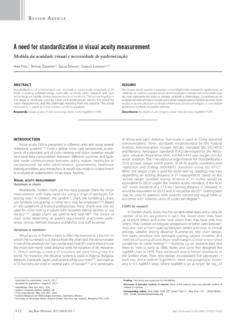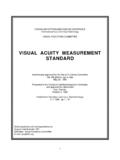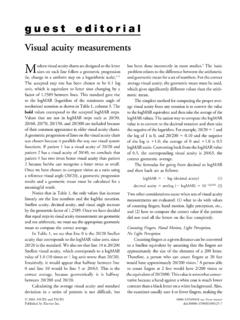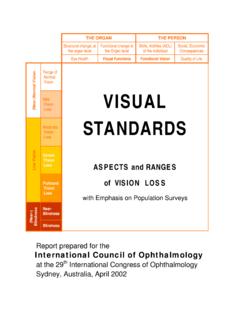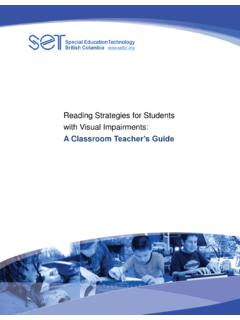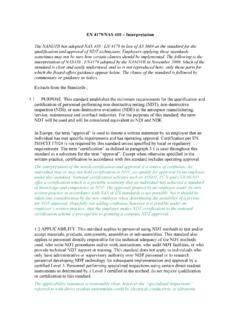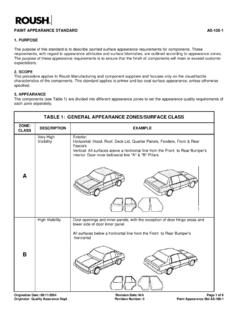Transcription of OPTICAL ABBREVIATIONS & GLOSSARY
1 OPTICAL ABBREVIATIONS & GLOSSARYOPTICAL ABBREVIATIONS20/20best vision approximate prism diopter degree of prism<less than>greater than increase decrease female malecombined with infinity+plus-minus A horizontal box measurementaapplanation tensionacbefore mealsacc accommodationADDadd power (multifocal)ARanti-reflective coating axaxis B vertical box measurementbblbarrel of hingeBCbase curveBDbase down prismBIbase in prismbifbifocalbidtwice dailyBObase out prismBOCdistance between OPTICAL center and top of segmentBUbase up prismBVPback vertex distancecwidth cccubic centimetercccomfort cable templeccwith correctioncf count fingersclcontact lenscmcentimeterCR-39plastic lens materialconvconvergentCRPC orneal reflection pupilometercylcylinderDdiopterDPdistance portion of lensDBLdistance between lenses
2 (bridge)DBCdistance between centersdivdivergent DxdiagnosisECPeyecare professionalEDeffective diametereomextraocular movementsesotendency to turn inexo tendency to turn outwardexamexaminationetesotropiaETedge thicknessfbforeign bodyFDC frame distance centerFPfar pointFtflat top bifocalGCgeometric centergttsdropsHDhorizontal decentration of OPTICAL centerhgtheightHIhi-index lens materialhmhand motionhorizhorizontalhsat bedtimehyperuphypodownhxhistoryicbetween mealsIOPintraocular pressureIOL intraocular
3 LensIPDinterpupillary distanceLleftliblibrary templelplight perceptionmmetermcmechanical centerMDPmonocular pupillary distancemmmillimeterMRPmajor reference pointnindex of refractionNegnegative__()Nlpno light perceptionnnnanometernpnear pointnrpnear reference pointnvnear visionNvanear visual acuityOCoptical centerODoculus dexter - right of OptometryOLoverall lengthOPCoptical product codeOphtophthalmic-pertaining to the eyesOrthostraightOSoculus sinister - left eyeOUoculus uniter - both eyesozoptical zonePALprogressive addition lensPcafter mealsPDpapillary distancephpinholePlplanopoper os - orallyprnas neededPRPprism reference pointqdevery dayqid4 times a dayq2hevery 2 hoursqhevery
4 Hourqodevery other dayRrightRefrefractionRxprescriptionswit houtscwithout correctionsegsegmentseg htsegment heightSIsegment insertskskullSphsphereSOPstandard operating procedureSRCscratch resistant coatingStat at onceSVsingle visionSxsymptoms ttensiontemptemporal toward the templetid3 times a daytritrifocalUVultravioletvNu value, ABBE valueVAvisual analysis (eye examination)VDvertical decentration of OPTICAL centervertverticalvfvisual fieldWNLwithin normal limitsxaxisxpexophoriaxtexotropiazylplas tic frame material__GLOSSARY20/20 The expression for normal eyesight (6/6 in metric measurements).
5 Expressed as a fraction, the numerator refers to the distance the patient is from the test chart the standard distance is 20 feet (6 meters). The denominator denotes the distance at which a person with normal eyesight could read the same line. For example, if the patient s visual acuity is 20/100 then the smallest line they correctly read at 20 feet could be read by a person with normal vision at 100 feet. The Snellen chart consisting of letters, numbers, or symbols is used to test visual acuity or the sharpness of eyesight.
6 A refraction test is used to determine the amount of correction needed for a prescription when treating refractive error such as astigmatism, myopia, or A Box Measurement The longest horizontal measurement of a lens; from the furthest nasal point to the furthest temporal point of a Value A measure of the degree to which light is dispersed when entering a lens. The average range is 20 to 60. A lower Abbe value causes greater dispersion of light resulting in chromatic aberration (color fringing) when viewed through the periphery of the lens.
7 A higher Abbe value results in less chromatic aberration. Abduction Outward movement of the eye Any flaw introduced during the manufacturing or grinding of a spectacle lens that can result in image blur. It may be inherent in the lens design or may result from an error in A substance used in friction process, such as grinding or Occurs when light is not reflected, refracted, or transmitted. The light energy is transformed into another form, such as Lens The ability of a lens to intercept or block general or specific wavelengths of radiant energy.
8 Designed to provide eye comfort against Ratio Accommodative convergence/ accommodative (measured in prism diopters/diopters). The convergence response of an individual (amount the eyes turn inward) in relation to the amount of stimulus of accommodation (eye focusing). The normal ratio is 4 The eye s focusing power enabling the eye to see clearly at different distances. This process is achieved by the lens of the eye changing its shape. Without the ability to accommodate, the image of an object would blur.
9 Accommodative Vergence A convergence response (to turn the eyes inward) which occurs as a direct result of accommodation (eye focusing).Achromatism- The ability of the eye to adjust the focal power to see objects at different The ability to respond to faint sense impressions or to distinguish light differences between stimuli. Adaptation/Adaptive process The maneuvers (conscious or unconscious, automatic or voluntary) by which the individual attempts to make organismic decisions as comfortable and gratifying as possible within the demands of that individual s Power (addition) The difference in spherical power between the distance and near corrections found in bifocals, trifocals, and progressive addition lenses to assist the eye s accommodation at a given distance.
10 This power is needed for near vision. Also referred to as add power or seg power. Addition The OPTICAL power (of a lens) required for near vision, in addition to that required for far Inward movement of the eye Nose Pads Type of bridge that consists of small pads made of plastic or silicone to help prevent slippage and aid in evenly distributing weight of glasses on bridge of the Phenomenon Ability of the eye to retain sight of an image during eye blinks. The most common example is seeing light after the flash of a camera.


